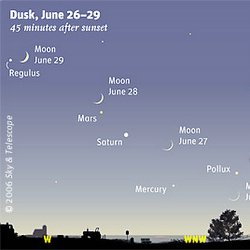
Black Skimmer [at Jones Beach, 2004]
Photo by Cal Vornberger

Last night was Midsummer's Night, the shortest night of the year. A few of us got together in the park around sunset to mark the occasion, entering through the Hunter's Gate at 81st Street and Central Park West.
Few people call the park entrances by their official names. In fact, all the original entrances to Central Park have names. My favorite is the Naturalist's Gate, at Central Park West and 77 St, across the street from the south end of the American Museum of Natural History.
The Hunter's Gate is also across the street from the natural history museum, at its north end; it was probably named for Theodore Roosevelt, a famous game hunter and the museum's founder. But I prefer to think that the Hunter's Gate refers to hunting in the form of seeking, as in mushroom hunting or fossil hunting. The American Museum certainly derives a lot of its fame and glory from its fossil collection, one of the greatest in the world.
The Solstice celebrants were in a hunting mood that evening, looking for night wildlife, and, perhaps, a few errant spirits said to be abroad on Midsummer's Night. Indeed, we were not disappointed.
First we saw two Black Skimmers arriving at Turtle Pond. That was at about 8:45. The mysterious birds [Where do they come from? Where do they go?] swooped and sailed around the pond, gliding back and forth, skimming the water's surface for little fish with their long lower mandibles open. Every year at least since the year 2000 Black Skimmers have been showing up at Turtle Pond at some point in June. This year their first arrival was noted by Bob Levy on June 11. We watched then on Midsummer's Night until it was too dark to see much more than a faint ghostly shape over the water.
While there we saw the Canada Goose parents and kids preening directly in front of our water-side vantage point. A Black-crowned Night-heron arrived from the direction of Belvedere Castle and promptly departed -- perhaps deterred by the Skimmers. They definitely look predatory. And prehistoric, like pteradactyls. An Eastern Kingbird twittered overhead, getting ready to roost for the night somewhere in the vicinity of his nearby nest.
Then straight for the Moth Tree, where not a single moth nor any other earthly or unearthly spirit chose to reveal itself to us. Only one medium-sized spider starting to spin a web at the base of the English Oak.
So we joined hands and danced around the tree, emitting mild yells and hollers and one loud screech-owl whinny. I've heard that there is a group of Wiccans [latter day witches and warlocks] who celebrate Midsummer's Night in the park every year with wild singing and dancing at the Ramble end of Bow Bridge. It would be nice to think that some of the people passing by the Moth Tree that night as we whooped it up and shook and shimmied thought we were the real thing. I kind of doubt it.










